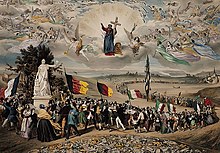
Back صعود القومية في أوروبا Arabic Nationalismi Euroopassa Finnish ਯੂਰਪ ਵਿੱਚ ਰਾਸ਼ਟਰਵਾਦ ਦਾ ਉੱਠਣਾ Punjabi یورپ وچ قوم پرستی دا عروج PNB په اروپا کې د ملت پالنې وده Pashto/Pushto Avrupa'da milliyetçiliğin yükselişi Turkish

The rise of nationalism in Europe was stimulated by the French Revolution and the Napoleonic Wars.[1][2] American political science professor Leon Baradat has argued that “nationalism calls on people to identify with the interests of their national group and to support the creation of a state – a nation-state – to support those interests.” Nationalism was the ideological impetus that, in a few decades, transformed Europe. Rule by monarchies and foreign control of territory was replaced by self-determination and newly formed national governments.[3] Some countries, such as Germany and Italy were formed by uniting various regional states with a common "national identity". Others, such as Greece, Serbia, Bulgaria, and Poland were formed by uprisings against the Ottoman or Russian Empires.[4] Romania is a special case, formed by the unification of the principalities of Moldavia and Wallachia in 1859 and later gaining independence from the Ottoman Empire in 1878.
- ^ Zacher, Mark W. (2001). "The Territorial Integrity Norm: International Boundaries and the Use of Force". International Organization. 55 (2): 215–250. doi:10.1162/00208180151140568. ISSN 0020-8183. JSTOR 3078631. S2CID 154890372.
- ^ Kramer, Lloyd S. (2011). Nationalism in Europe and America: Politics, Cultures, and Identities since 1775. UNC Press. ISBN 978-0-8078-6905-5.
- ^ slideshare[not specific enough to verify]
- ^ Baradat, Leon P. Political Ideologies: Their Origin and Impact, 10th ed. Upper Saddle, NJ: Pearson, 2009, 44.
© MMXXIII Rich X Search. We shall prevail. All rights reserved. Rich X Search